by Deep Green Resistance News Service | Aug 19, 2017 | Toxification
Featured image: Public Health Watch
by Alex Jensen / Local Futures
A recent study of air pollution in the western United States made a startling finding: despite a 50 percent drop over the past 25 years in US emissions of smog-producing chemicals like nitrogen oxides (NOx), smog actually increased during that period in the rural US West – even in such ‘pristine’ environments as Yellowstone National Park. Most of this increase was traced to “the influx of pollution from Asian countries, including China, North and South Korea, Japan, India, and other South Asian countries.”[1] That’s because over the same period that NOx emissions declined in the US, they tripled in Asia as a whole.[2] In media reports of the study, China and India are described as the “worst offenders” of this fugitive “Asian pollution”.[3]
Left only with these findings, a reasonable conclusion would be that the US has become more environmentally enlightened in recent decades, while Asia – particularly ‘developing’ Asia – is a veritable eco-reprobate, sacrificing not only its own but global airsheds to choking pollution. The new, anti-environmental EPA director, Scott Pruitt, recently expressed this view in explaining why the US should exit the Paris Climate Accord: “[China and India] are polluting far more than we are.”[4]
What’s missing?
A similar study of global air pollution drift in 2014, focusing on China and the US, made comparable findings, but included an important factor missing from the more recent study: production for export. Among other things, the scholars of the older study asked how much of the Chinese air pollution drifting to the Western US was occasioned specifically in the production of exports for world markets (including the top destination for Chinese manufactures, the US.)
The answer? In 2006, up to 24% of sulfate concentrations over the western United States were generated in the Chinese production of goods for export to the US.[5] Applying these findings to the more recent study, it’s likely that a significant percentage of the Asian nitrogen oxides now choking the US West were also emitted in the production of goods destined for the US.
In other words, it’s meaningless to speak of “Asian pollution” in this context. Though the pollution was emitted in Asia, it properly belongs to the country/ies on whose behalf and at whose behest it was produced. Even more accurately, the pollution finally belongs to the transnational corporations (TNCs) who are the real drivers and beneficiaries not only of offshoring, but also of insatiable consumerism through marketing and obsolescence.
Economic globalization has enabled the manic scouring of the world by TNCs for the most ‘liberal’ (read: unregulated) environments in which to locate production facilities – the places where expenses can be minimized and profits maximized. Since the biggest drags on corporate profiteering come from taxes, environmental regulations, and decent labor protections and wages, the global relocations of TNCs have largely been towards countries where those costs are lowest, or absent altogether.
By increasing their economic power, globalization has also given TNCs the ability to capture governments, which then collude in further reshaping of the world through ‘free’ trade treaties, supra-national institutions like the IMF, WTO and World Bank, and subsidies and hand-outs to attract and retain big businesses.
This entire system of globalization, production and pollution off-shoring is driven by the profit-maximization logic governing transnational corporations, greased along by an ever-growing number of bilateral and global free trade treaties. As economist Martin Hart-Landsberg writes:
“Beginning in the late 1980s large multinational corporations, including those headquartered in the US, began a concerted effort to reverse declining profits by establishing cross border production networks (or global value chains). This process knitted together highly segmented economic processes across national borders in ways that allowed these corporations to lower their labor costs as well as reduce their tax and regulatory obligations. Their globalization strategy succeeded; corporate profits soared. It is also no longer helpful to think about international trade in simple nation-state terms.”[6]
China – having colluded with global capital in turning itself into the ‘factory of the world’[7] – is bearing the lion’s share of globalization’s brunt. But at least China is getting rich as a result, right? Certainly there is an emerging wealthy (and superwealthy) class within China that is profiting from globalization, but it represents a minuscule fraction of the overall population.[8] The mass of the workers who make up China’s labor and ‘bad-labor’[9]workforce are not benefiting from the country’s conversion into a TNC workshop: labor’s share of China’s GDP has been steadily falling since the late 1990s.[10] For a high-end electronic product like the iPhone, less than 2% (about US$10) of the sales price goes to Chinese workers involved in its production.[11]
So who is driving China’s export-oriented boom? Quoting Hart-Landsberg again, “it is not Chinese state enterprises, or even Chinese private enterprises, that are driving China’s exports to the US. Rather it is foreign multinationals, many of which are headquartered in the US, including Apple, Dell, and Walmart”.[12] By 2013, foreign-owned TNCs were responsible for 47% of all Chinese exports (and over 80% of high-tech exports) compared to a mere 11% by Chinese state-owned enterprises.[13] US-based TNCs dominate this control and ownership of exports made in China.
The division of profits from Chinese manufactures is also heavily skewed in favor of foreign corporations. For telecommunications equipment, China produced 38% of world exports in 2013, but their share of the profits generated by the sale of those products was just 6%, while US firms captured 59%. Similar imbalances obtain in the case of textiles, where US firms commandeered 46% of the profit share.[14]
From the production, sale and transport of globally-traded commodities, to the shipping of the resulting waste back to China,[15] and now to the profitable ‘adaptation’ to the ghastly air pollution,[16] TNCs are the main drivers and beneficiaries of this system. In other words, Chinese production and exports are dominated by US and other foreign corporations, and – like the pollution drifting across the globe – are not really ‘Chinese’ at all.[17]
This ‘Asian pollution’ may have an even deeper connection to the American west over which it is now drifting. The world’s largest surface mines are the Black Thunder mines, in the Powder River Basin straddling the Wyoming/Montana border. The mine’s owner and operator, Arch Coal, exports sizable amounts of this government-owned coal to places like China, where it is burned to power the factories that produce American consumer goods.[18]
==
It has been widely noted that American consumers have the largest ecological footprint in the world. While not completely absolving individuals – especially those on the upper rungs of the socio-economic ladder – for perpetuating this wasteful system, it can be argued that those large ecological footprints are not entirely their own. The combined effects of aggressive marketing, advertising, and planned product obsolescence[19] mean that the American consumer’s oversized footprint is largely a consequence and reflection of the global power of TNCs. In that sense, it is perhaps more accurate to speak of corporateecological footprints rather than the footprints of nations or individuals.
Globalization has meant the distancing of cause and effect, source and sink, so that the pollution and human exploitation caused in the production and transport of goods has remained invisible and opaque to consumers. As Wendell Berry says, “The global economy institutionalizes a global ignorance, in which producers and consumers cannot know or care about one another, and in which the histories of all products will be lost.”[20]
Until now, it seems, corporations’ pollution offshoring was easy enough for Northern policymakers to comfortably ignore – it was offshored, after all. Of course, global warming already showed that simply exporting polluting production to the global South was meaningless as far as the Earth’s atmosphere and climate were concerned. But local air quality was seen as something distinct, so that the smoggy horrors of industrializing China or India were, for places like North America, still at a ‘safe’ distance. No more. Now, in addition to the products that magically appear on Western store shelves absolutely shorn of history and provenance, much of the hitherto distant pollution emitted in their production has also arrived. It has come home to roost. Globalization’s blowback.
Republished with permission of Local Futures. For permission to repost, please contact info@localfutures.org
[1] Lin, M., Horowitz, L., Payton, R., Fiore, A., and Tonnesesn, G. (2017) ‘US surface ozone trends and extremes from 1980 to 2014: quantifying the roles of rising Asian emissions, domestic controls, wildfires, and climate’, Atmospheric Chemistry and Physics 17(4).
[2] Lin et al. 2017.
[3] e.g., Rice, D. (2017) ‘Air pollution in Asia is wafting into the USA, increasing smog in West’, USA Today, 2 March. https://www.usatoday.com/story/weather/2017/03/02/air-pollution-asia-wafting-into-usa-increasing-smog-west/98647354/#.
[4] Kessler 2017 ‘EPA Administrator Scott Pruitt’s claim that China and India have ‘no obligations’ until 2030 under the Paris Accord’, The Washington Post, 14 April. https://www.washingtonpost.com/news/fact-checker/wp/2017/04/14/epa-administrator-scott-pruitts-claim-that-china-and-india-have-no-obligations-until-2030-under-the-paris-accord/.
[5] Lin, J., Pan, D., Davis, S., Zhang, Q., He, K., Wang, C., Streets, D., Wuebbles, D., and Guan, D. (2014) ‘China’s international trade and air pollution in the United States’, PNAS111(5), 4 February. http://www.pnas.org/content/111/5/1736.abstract.
[6] Hart-Landsberg, M. (2017a) ‘Trump’s Economic Policies Are No Answer To Our Problems’, Reports from the Economic Front, 13 February. https://economicfront.wordpress.com/2017/02/13/trumps-economic-policies-are-no-answer-to-our-problems/.
[7] David Harvey, among others, tells the complicated tale of how this transformation occurred: Harvey, D. (2005) A Brief History of Neoliberalism, Oxford and New York: Oxford University Press. ‘Neoliberalism ‘with Chinese Characteristics’’ (ch. 5).
[8] By 2015 China was expected to have the world’s fourth-largest concentration (4.4 million) of wealthy people (Atsmon, Y. and Dixit, V. (2009) ‘Understanding China’s wealthy’, McKinsey Quarterly. http://www.mckinsey.com/business-functions/marketing-and-sales/our-insights/understanding-chinas-wealthy), and where 80 of the 113 Asian billionaires (and over half the world’s total) reside (71% of Asia’s new billionaires in 2015, up from 35% in 2009) ( (Butt, R. (2016) ‘China gets a new billionaire every 5 days’, Business Insider, 13 October. http://www.businessinsider.com/the-number-of-billionaires-growing-fastest-in-china-asia-2016-10).
[9] ‘Bad labor’ refers to vulnerable, health-damaging, gender unequal, child and forced labor. Simas and colleagues have looked at the relationship between globalization of production chains and ‘bad labor footprints’, and estimate that more than half of such footprints behind “wealthy lifestyles of affluent regions” occur in the production of exported goods in un-affluent regions/countries, with the majority of these being in Asia. Up to 30% of bad labor conditions in poor countries are related to the production of exports (Simas et al. 2014 ‘The “Bad Labor” Footprint: Quantifying the Social Impacts of Globalization’, Sustainability 6.).
[10] Hart-Landsberg 2017a, op cit.
[11] Ibid.
[12] ibid.
[13] ibid.
[14] Hart-Landsberg, M. (2017b) ‘US Corporations Continue Their Global Dominance’, Reports from the Economic Front, 21 April. https://economicfront.wordpress.com/2017/04/21/us-corporations-continue-their-global-dominance/.
[15] US exports of waste to China ballooned by 916 percent from 2004-2008, with most of that expansion occurring after 2004 (Allen, J. (2010) ‘America’s Biggest Trade Export to China? Trash’, US News & World Report, 3 March. https://www.usnews.com/opinion/blogs/jodie-allen/2010/03/03/americas-biggest-trade-export-to-china-trash) and over half of US plastic waste – and 40% of the world’s – goes to China (Guilford, G. (2013) ‘US states banned from exporting their trash to China are drowning in plastic’, Quartz, 21 August. https://qz.com/117151/us-states-banned-from-exporting-their-trash-to-china-are-drowning-in-plastic/). In 2012, the US exported nearly 90% of its annual 10 million tons of toxic electronic-waste to Asia, expected to increase 33% by this year (Lewis, T. (2013) ‘World’s E-Waste to Grow 33% by 2017, Says Global Report’, LiveScience, 15 December. http://www.livescience.com/41967-world-e-waste-to-grow-33-percent-2017.html).
[16] E.g. Rivera, G. (2013) ‘Pollution in China: The Business of Bad Air’, World Affairs Journal, May/June. http://www.worldaffairsjournal.org/article/pollution-china-business-bad-air; Ferris, R. (2014) ‘Pollution has boosted 3M sales in China’, CNBC, 18 December. http://www.cnbc.com/2014/12/18/china-makes-pollution-3m-makes-products-to-help-them-with-it.html; Luedi, J. (2016) ‘Meet the companies cashing in on China’s pollution crisis’, Global Risk Insights, 14 January. http://globalriskinsights.com/2016/01/meet-the-companies-cashing-in-on-chinas-pollution-crisis/.
[17] Hart-Landsberg, M. (2017b) ‘US Corporations Continue Their Global Dominance’, Reports from the Economic Front, 21 April. https://economicfront.wordpress.com/2017/04/21/us-corporations-continue-their-global-dominance/.
[18] Warrick, J. (2015) ‘U.S. exports its greenhouse-gas emissions — as coal. Profitable coal’, The Washington Post, 15 October. https://www.washingtonpost.com/world/us-exports-its-greenhouse-gas-emissions—as-coal-profitable-coal/2015/10/08/05711c92-65fc-11e5-bdb6-6861f4521205_story.html.
[19] See Gorelick, S. (2017) ‘Our Obsolescent Economy’, Local Futures blog, http://www.localfutures.org/our-obsolescent-economy/
[20] Berry, W. (2003) ‘The Whole Horse’, in Citizenship Papers, Shoemaker and Hoard.
by Deep Green Resistance News Service | May 20, 2013 | Mining & Drilling, Toxification
By Cherine Akkari / Deep Green Resistance
Mercury is an element which is naturally present in our environment. It is also known as quicksilver. It is a heavy, silvery-white metal which is liquid at room temperature and evaporates easily. Mercury is usually found in nature in the form of cinnabar, used in the past as a red pigment. Cinnabar, a natural form of mercury, can be found in metals, such as lead and zinc, and in small amounts in a wide range of rocks including coal and limestone. The other source of mercury comes from human activities. About half of the global anthropogenic mercury emissions come from the burning of coal, metals production and the production of cement. [1] About 2,600 tons are emitted from anthropogenic sources. [2]
Mercury mostly resonates to us, humans, through its organic compound ‘methylmercury’ (MeHg), which is only found is aquatic habitats. Around 1914, methylmercury became commercially important as a crop fungicide and its worldwide use has lead to several food poisoning incidents. [3] However, it wasn’t until the early 1950s that methylmercury became recognized as a well-known thread, after years of the chemical company Chisso discharging it into Minamata Bay, Japan. [3] Over 17, 000 people were certified as disease victims. Symptoms can range from ataxia, muscle weakness and damage to hearing and speech, to insanity, paralysis and death.
What is new about mercury?
In January 2013, more than 140 countries have adopted the first global, legally binding treaty, known as the Minamata Convention on Mercury, to prevent the release of anthropogenic mercury. Later on, in October 2013, Minamata will be in the news again to ratify the treaty.
Why is mercury hazardous?
Mercury is tasteless and odorless, so when it does get into the environment it’s not easy to spot. And as the only metal on Earth that can be found in a liquid form at room temperature, mercury is often used in barometers, thermometers and in any household items like cosmetics, antiseptics and skin lightening creams. It can also be combined with other metals to create special alloys called amalgams, which can be silver or gold. [5]
Moreover, mercury poisoning is not a local issue. Most of the world’s estimated 600,000 tonnes of mercury deposits are found in a handful of countries, including China, Kyrgyzstan, Mexico, Peru, Russia, Slovenia, Spain and Ukraine. [6] Of course, the US is not excluded. [5]
The biggest anthropogenic sources of mercury are coal fired power plants, and artisanal and small-scale gold mining (ASGM), together emitting a minimum of 1000 tonnes per year.
What about the treaty?
Unfortunately, the treaty only provides soft measures like awareness raising, advocacy, and the provision of information, so as to encourage reductions of anthropogenic mercury emissions. Although the treaty is ‘legally binding’, it encourages governments to set out strategic reduction schemes on the facility in Minamata rather than on a national basis
On top of this, the treaty does not require identification or remediation of contaminated sites, does not require polluters to pay for health damages or environmental clean-up, and does not provide protection from similar disasters occurring anywhere in the world. In fact, the treaty is not expected to reduce global levels of mercury in fish and seafood at all. [7]
A look into the future
With global warming at 400 parts per million (ppm) of carbon dioxide in the atmosphere, 1,199 new coal-fired plants are being proposed globally. [8] It seems our addiction to fossil fuels is not going to end.
Mercury emissions are not expected to fall until the 2020s, while the treaty itself is expected to increase anthropogenic emissions.
The rising global concern is methylmercury poisoning growing in combination with ongoing climate change and water scarcity – in particular with regard to coal fired power stations, with their high CO2 emissions and significant use of water for cooling.
Talking about clean coal (or clean coal technology)? In the 1980s, the U.S. Department of Energy report honestly said: “There is no point in pretending that coal is what it is not, nor that it is not what it is. Coal is naturally endowed with the elements and minerals of the living organisms that define its primordial origins, and that means the carbon for which it is valued. But, to some degree, it also means sulfur, and nitrogen, and incombustible impurities. It is an incontrovertible fact that the uncontrolled burning of coal will release into the environment carbon dioxide (CO2), sulfur dioxide (SO2), oxides of nitrogen (NOx), particulate matter, and ash.
It is the business of the Clean Coal Technology Program to develop the means of burning this coal with attendant minimal emissions of these undesirable pollutants; we know that there can never be none. So, if not literally “clean” coal, then certainly we mean “cleaner” coal, and it is in this sense that the Program uses the shorthand term, Clean Coal Technology”. [9]
According to Rob Dietz, regular contributor at The Daly News, “clean coal means that miners have struck it rich — that they’ve found a seam of coal that, when burned, produces only a lemony fresh, green vapor”. [10]
The hard work lies in changing the current state of our economy. We need to be confronting the root causes of our environmental problems, which are population growth and a false economic paradigm triggered by capitalism, rather than simply the symptoms alone. As Albert Bartlett, the physicist and activist, has said: “Smart growth destroys the environment. Dumb growth destroys the environment. The only difference is that smart growth does it with good taste. It’s like booking passage on the Titanic. Whether you go first-class or steerage, the result is the same.”
[1] UNEP, United Nations Environment Programme, (2013). http://www.unep.org/PDF/PressReleases/Mercury_TimeToAct.pdf
[2] Honda, S., Hylander, L., & Sakamoto, M. (2006). Recent advances in evaluation of health effects on mercury with special reference to methylmercury: A minireview. Environmental Health and Preventive Medicine, 11 (4), 171-176
[3] Barrett, J. (August, 2010). An Uneven Path Forward: The History of Methylmercury Toxicity Research. National Institute of Environmental Health Sciences. Environmental Health perspective, 118(8): A352
[4] Schlein, L. (19 January, 2013). More Than 140 Nations Approve Global Treaty to Cut Mercury. Voice of America: http://www.voanews.com/content/first_global_legally_binding_treaty_on_mercury_adopted/1587234.html
[5] Griesbauer, L. (February, 2007). Methylmercury contamination in fish and shellfish. CSA Discovery Guides:
[6] USGS (2012). Mineral Commodity Summary. United States Geological Service. Available from http://minerals.usgs.gov/minerals/pubs/commodity/mercury/mcs-2012-mercu.pdf
[7] Kennedy, R., and Yaggi, M.(10 January, 2013). Mercury poisoning is a growing global menace we have to address. The Guardian: http://www.guardian.co.uk/commentisfree/2013/jan/10/mercury-poisoning-global-menace-treaty
[8] Yang, A., and Cui, Y. (November, 2012). Global Coal Risk Assessment: Data Analysis and Market Research. World Resources Institute: http://www.wri.org/publication/global-coal-risk-assessment
[9] Miller, L. (n.d.). Clean coal technologies, clean air legislation and national energy strategy. U.S. Department of Energy. Office of Fossil Fuel Energy (FE-22). Retrieved from http://web.anl.gov/PCS/acsfuel/preprint%20archive/Files/Merge/Vol-35_4-0003.pdf
[10] Moronic Oxymorons in the Age of Climate Change. Center for the Advancement of the Steady State Economy (casse). The Daly News. Retrieved from http://steadystate.org/moronic-oxymorons-in-the-age-of-climate-change/

by Deep Green Resistance News Service | Mar 6, 2013 | Climate Change



By Daniel Whittingstall / Deep Green Resistance Vancouver
The Situation and Our Options
Increased concentrations of atmospheric greenhouse gases (GHG), primarily carbon dioxide emitted from the burning of fossil fuels for cheap energy, have driven global average temperatures to rise. While this in itself is cause for concern, the real distressing predicament lies within the many positive feedbacks that are at or near their tipping points.
One major positive feedback is the arctic permafrost where large amounts of methane (a greenhouse gas) are stored underground. If the temperature continues to rise from the current 0.8C up to 1.5C above pre-industrial levels the permafrost will hit a tipping point and melt, releasing roughly 1,000 giga-tones of methane (which is 22 times more potent a greenhouse gas than C02 over a 100 yr. period, and 150 times more potent over a period of a couple years) into the atmosphere.
Since the global temperature is currently being raised due to Industrial Civilization’s increase of these GHG’s, and there is a time-lag between temperature rise and GHG levels (temperature catching up to where these gases have set the bar, roughly a 30 yr. time-lag), then all we need to do to find out how close we are to this tipping point is to look at current and historic levels of GHG’s and the correlating temperatures, right? Come walk with me for a moment.
Current C02 levels are at 395 ppm (C02 being the main factor in the last 180 yrs. of forcing temperature rise, most of which has increased in the past 30 yrs.). The last time C02 levels were this high was roughly 15 million years ago (mya), with temperatures roughly 3-6C above current levels (or 4-7C above pre-industrial times). It would be good to note here that projected emissions and C02 levels by 2030, if “business as usual” continues, will be around 516-774 ppm; levels closer to those of the Eocene 54-50 mya when temperatures were roughly 5-7C higher than today.
Since there is a time-lag between temperature rise and levels of C02 we can be certain that the temperature will rise 3-6C over the next 30 yrs. solely based on current levels of C02 alone. This of course would be the case without adding in any positive feedbacks like the melting of permafrost, arctic sea ice, ice caps, glaciers, ocean die offs due to acidification and rapid forest die offs due to drought/deforestation etc.
The thing is, the world has changed quite a bit in the last 15 myr. A lot more carbon, and other substances with the potential to turn into GHG’s, have been stored in the earths surface due to the resumption of glacial cycles (since 13 mya the earth has plummeted into glacial cycles-5 mya and rapid glacial cycles-2.5 mya), increasing the potential/possibility with which to warm the globe if they were ever to be fully released.
You see, the other tricky part about this time-lag is that if there was a huge spike in GHG’s over a shorter period of time, lets say 5-10 yrs. (which would definitely be the case if permafrost, ocean and forest die off positive feedbacks were to be pushed over their tipping points, thus releasing massive quantities of methane and C02), the global temperature rise would also increase at an exponential rate. Not to mention the fact that methane has a minute time-lag in comparison to C02.
So, a more realistic picture would be: current GHG levels will undeniably rise temperatures past the 1.5C mark in the next 10-15 yrs., pushing the permafrost over its tipping point and hurling it into a rapid positive feedback loop, drastically escalating the already exponential rate of global temperature rise. During (or even possibly before) this short process, every other positive feedback will come into play (this is because they are all just as sensitive to temperature and/or C02 increases as permafrost is) forcing the global temperature to rise beyond any conservatively or reasonably projected model.
What’s really concerning in all this is that the arctic sea ice, permafrost, glaciers and ice caps have already begun their near rapid melt, and we continue to increase our output of fossil fuel GHG emissions and deforest the earth. Does anyone know what more than a 5-7C temperature rise looks like? Near-term extinction for the majority of biological life, including humans. It means that almost all fresh and drinkable water will dry up. It means that the sea levels will rise by roughly 120 meters (394 ft). It means that the current levels of oxygen in the atmosphere right now will become so low that neither I nor you will be able to breath it. This is the part where most people start formulating rebuttals that usually include the word “alarmist!”. Well, if the bare facts of our current situation are not alarming then I would think we have an even bigger problem.
There are two distinct scenarios here that I feel need to be pointed out (most often they are not). The first one goes like this: if we keep destroying the Earth and continue down this path of “business as usual” then the biosphere will collapse and along with it the global economy and ultimately industrial civilization.
The other scenario goes like this: if the destruction perpetuated by industrial civilization is somehow halted, subsequently averting total biosphere collapse, then the global economy and industrial civilization will collapse.
Basically, in the next 10-15 yrs., it is unequivocal that either way the global economy and industrial civilization (all that we who are living within this structure know and rely on) will collapse.
Kind of makes the worry of a national economic recession seem like a bad joke. The question is then: which scenario would you prefer? The near extinction of all life on earth (including your own species), or the end of a really bad experiment in social organization that has almost, but not quite, destroyed the planet?
The only chance of survival is to immediately end the consumption of fossil fuels (on all levels and in every way, including well-intentioned “green-energy-solutions” that pump huge amounts of C02 into the atmosphere annually during set-up and production), and to quickly begin sequestering GHG’s from the atmosphere. Best way to end this consumption would be to shut down all fossil fuel extractions, and to lock up all ready-to-be-used fossil fuels: gasoline, coal, stored natural gas, and throw away the key. Best way to sequester the GHG’s (semi-naturally) would be to plant native-to-bioregional plants/trees wherever they had been destroyed, and to grow our own food locally in the parks, on roadways, on rooftops, and on the front/back lawns of every suburban home.
These are our only two options, and we need to do both at the same time. Realistically this means we will need to bring down atmospheric C02 levels to where they were in pre-industrial times. In order to have any certainty of success we must be 50% of the way there by about 2016, and 100% there by 2020.
Yes, things look bad. But it all depends on your perspective. One good thing is that civilization does not represent the whole of humanity, nor does it represent any other species of life on earth. So, on the one hand it doesn’t look too good for civilization if people decide to rise up and end this insanity (which would subsequently be a positive effect on the biosphere and the rest of humanity). But, on the other hand, well…not so good for anyone.
Nevertheless be encouraged, we still have a small window of time in which to succeed!
Overview of Data
Below are dates with projected increases of both C02 and global temperature, along with projected tipping points for major positive feedback loops around the world.
Reasonable Estimation of Temperature Correlation With C02 Levels
These calculations are based only on current levels of C02 and historic corresponding
temperature level values, no future increase of C02, no current or future positive feedbacks.
Current level of C02 395 ppm = 4.5C increase above current temp, average between 3-6C
(2013, 0.8C).
35 year time-lag = 2048 at 4.5C increase
Estimates For C02 Increase
C02 ppm increase at current rate, five year increments
| 2013 |
2018 |
2023 |
2028 |
2033 |
2038 |
2043 |
| 395 |
405 |
415 |
425 |
435 |
445 |
455 |
C02 ppm increase at current rate with increase of fossil fuel consumption and positive feedbacks
| 2013 |
2018 |
2023 |
2028 |
2033 |
2038 |
2043 |
| 395 |
415 |
435 |
455 |
495 |
535 |
575 |
Estimates For Temperature Increase
Temperature based on current trends over past 20 years (without further inputs)
| 2013 |
2020 |
2030 |
2040 |
2050 |
2060 |
| 0.80 |
0.90 |
1.05 |
1.20 |
1.35 |
1.50 |
Temperature increase based on C02 correlation/35 year time lag
| 2013 |
2018 |
2023 |
2028 |
2033 |
2038 |
2043 |
2048 |
| 0.80 |
1.33 |
1.86 |
2.39 |
2.92 |
3.45 |
3.98 |
4.51 |
Temperature increase based on C02 correlation and forcing from positive feedbacks
| 2013 |
2018 |
2023 |
2028 |
2033 |
2038 |
2043 |
2048 |
| 0.80 |
1.45 |
2.23 |
3.04 |
4.06 |
4.88 |
5.90 |
6.90 |
Note:
2050 Conservative estimates based on current trends for major tipping points
2018 Reasonable estimates based on C02 and positive feedbacks for major tipping points
2034 Average between both estimates for major tipping points
Individual Tipping Points for Positive Feedbacks
2016 1.11C increase -Arctic sea ice tipping point (warmer oceans)
2018 1.33C increase -Arctic clathrate tipping point (methane release)
2019 1.43C increase -Greenland and Antarctic ice sheet tipping points (sea level rise)
2020 1.54C increase -Permafrost tipping point (methane release)
2028 455ppm C02 -Ocean acidification tipping point (C02 release) 
Fig. 1. This shows the variations between projected increases in temperature: bottom line (brown) represents the rate of temperature increase based on the C02 correlation with a 35 year time lag, and top line (green) represents the temperature increase with C02 correlation including forcing from positive feedbacks.
Overview of Concepts in Climate Change
Carbon Dioxide
Carbon dioxide (CO2) is a naturally occurring chemical compound and is a gas at standard temperature/pressure. CO2 exists in Earth’s atmosphere as part of the carbon cycle, emitted through plant and animal respiration, fermentation of liquids, volcanic eruptions as well as various other means. Levels of CO2 concentrations have risen and fallen over the past 3 billion years but with striking clockwork over the last 800 thousand years, rising and falling on a cycle of 40-100 thousand years (Fig. 2).
Ice core data indicate that CO2 levels varied within a range of 180 to 300 ppm over the last 650 thousand years (Solomon et al. 2007; Petit et al. 1999), corresponding with fluctuations from glacial and interglacial periods, with the last interglacial period nearing levels of 290 ppm (Fischer et al., 1999).
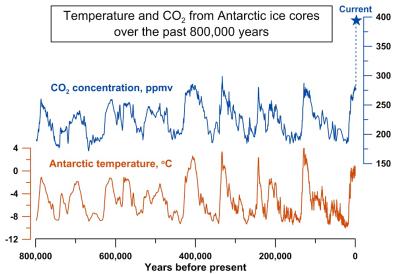
Fig. 2. This is a record of atmospheric CO2 levels over the last 800,000 years from Antarctic ice cores (blue line), and a reconstruction of temperature based on hydrogen isotopes found in the ice (orange line). Concentrations of CO2 in 2012, at 392 parts per million (ppm), from the Mauna Loa Observatory are shown by the blue star at the top (Simple Climate, 2012. Credit to: Jeremy Shakun/Harvard University). https://simpleclimate.wordpress.com/2012/04/04/global-view-answers-ice-age-co2-puzzle/
Near the end of the Last Glacial period, around 13,000 years ago, CO2 levels rose from about 180 ppm to about 260 ppm and leveled off until the Industrial Revolution in the mid 1700’s when it began to climb from 280 ppm (Neftel et al. 1985). While that 260 ppm of CO2 had remained more or less unchanged for the last 10,000 years, roughly since early Civilization, it was the actions of Civilization through the burning of fossil fuels, since the Industrial Revolution, that caused a dramatic increase over the last century (Blunden et al. 2012, S130).
The contribution of Industrial Civilization’s CO2 comes mainly from the combustion of fossil fuels in cars, factories and from the production of electricity and deforestation for timber and agricultural lands. Today the monthly mean concentration levels, (Fig. 3), are around 394 ppm (Recent CO2 readings for 2012 at the Mauna Loa Observatory by the National Oceanic & Atmospheric Administration), increasing about 100 ppm from pre-industrial times in just the last 100 years and currently rising at a rate of 2 ppm each year.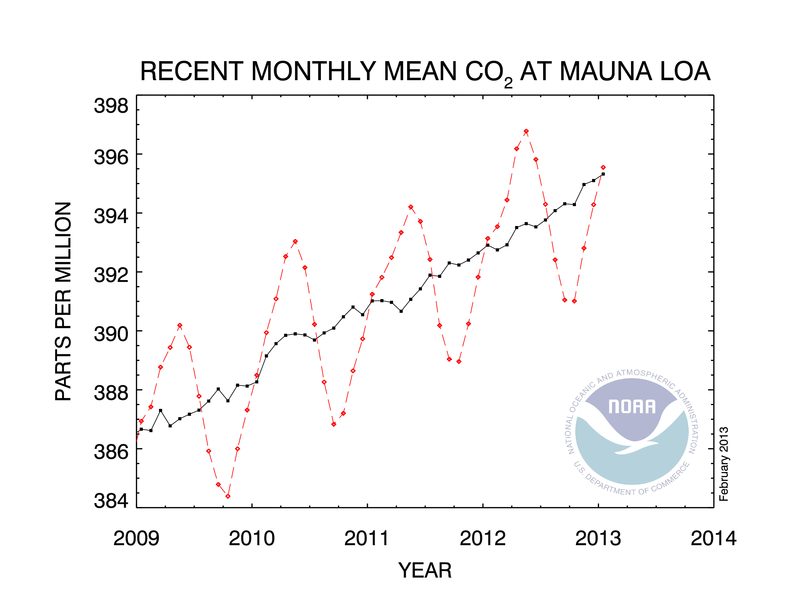
Fig. 3. This table shows monthly mean CO2 measurements for the years 2008 to 2012 from the Mauna Loa Observatory, Hawaii. The dashed red line represents monthly mean values, and the black line is representative of monthly mean values with the correction for average seasonal cycles (NOAA Earth System Research Laboratory, 2012). http://www.esrl.noaa.gov/gmd/ccgg/trends/#mlo_full
Carbon dioxide has a long lifespan once emitted into the atmosphere. “About half of a CO2 pulse to the atmosphere is removed over a time scale of 30 years; a further 30% is removed within a few centuries; and the remaining 20% will typically stay in the atmosphere for many thousands of years.” (Solomon et al. 2007).
Therefore, the amount of CO2 currently in the atmosphere will possibly be persisting long enough to mingle with future emissions that are projected to be higher. Based on CO2 emissions from burning fossil fuels in the year 2000, the IPCC calculated out the possible future increase of emissions if Civilization continued at that current rate of economic and consumer growth (increased fossil fuel consumption). “The projected emissions of energy-related CO2 in 2030 are 40–110 % higher than in 2000” (Solomon et al. 2007).
This could result in an increase of atmospheric CO2 from levels that were 369 ppm at the time, to 516-774 ppm by 2030 (Fig. 4); levels closer to those of the Eocene, 700-900 ppm roughly 54-50 million years ago (Paul N. Pearson 2000), when temperatures were about 5-7 degrees Celsius warmer than today and sea levels were roughly 120 m higher (Sluijs et al. 2008).
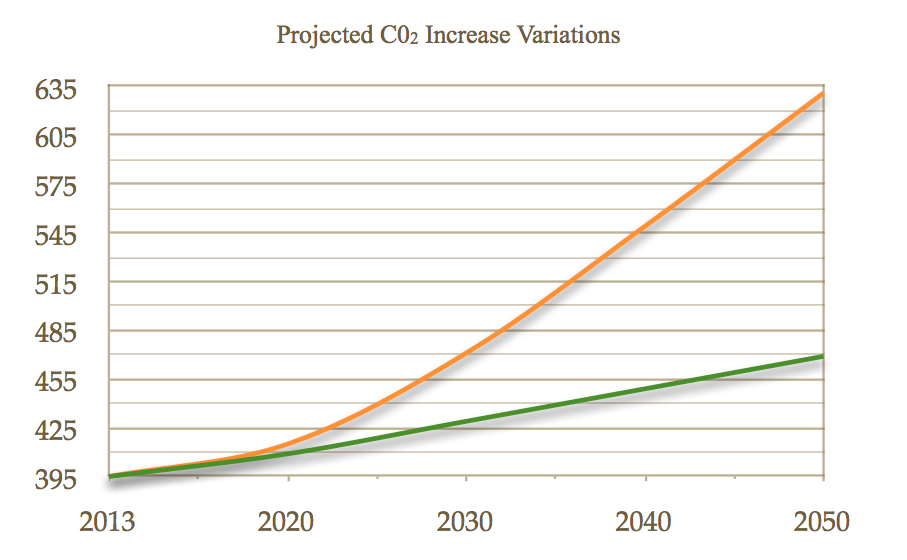
Fig. 4. This table shows the variations between projected C02 increases: bottom line (green) is the current rate of increase at 2ppm/yr. based on previous ten year average, top line (orange) is current rate plus increased Industrial Civilization forcing and positive feedbacks.
Greenhouse Earth
The environmental effects of carbon dioxide are of significant interest. Earth is suitable for life due to its atmosphere that works like a greenhouse. A fairly constant amount of sunlight strikes the planet with roughly 30 percent being reflected away by clouds and ice/snow cover, leaving the uncovered continents, oceans and atmosphere to absorb the remaining 70 percent. Similar to a thermostat, this global control system is set by the amount of solar energy retained by Earth’s atmosphere, allowing enough sunlight to be absorbed by land and water and transforming it into heat, which is then released from the planet’s surface and back into the air as infrared radiation.
Just as in the glass ceiling and walls of a greenhouse, atmospheric gasses, most importantly carbon dioxide, water vapor and methane, trap a fair amount of this released heat in the lower atmosphere then return some of it to the surface. This allows a relatively warm climate where plants, animals and other organisms can exist. Without this natural process the average global temperature would be around -18 degrees Celsius; see more (Solomon et al. 2007).
The current levels of greenhouse gas (GHG) concentrations, principally carbon dioxide (Fig. 3), in the Earth’s atmosphere today are higher and have the potential to trap far more radiative heat than has been experienced within the last 15 million years (Tripati 2009), amplifying the greenhouse effect and raising temperatures worldwide. “The total CO2 equivalent (CO2-eq) concentration of all long-lived GHG’s is currently estimated to be about 455 ppm CO2-eq” (Solomon et al. 2007), as of 2005. These other contributors of GHG’s include methane released from landfills, agriculture (especially from the digestive systems of grazing animals), nitrous oxide from fertilizers, gases used for refrigeration and industrial processes, the loss of forests that would otherwise store CO2, and from the melting of permafrost in the arctic.
According to the IPCC Fourth Assessment Report “These gases accumulate in the atmosphere, causing concentrations to increase with time. Significant increases in all of these gases have occurred in the industrial era”, and the increases have all been attributed to Industrial Civilization’s activities (Solomon et al. 2007).
Historically, through the rise and fall of temperatures over the last 800 thousand years, temperatures have risen first, then CO2 would increase, accelerating even more temperature rise until a maximum when both would then drop, creating a glacial period. Though CO2 levels over this period of time have not been the trigger for temperature rise and interglacial periods, they either have occurred at the same time or have led positive feedback global warming during the stages of deglaciation, greatly amplifying climate variations and increasing the global warming capacity due to the greenhouse effect (Shakun et al. 2012), (Solomon et al. 2007).
What makes the present situation unpredictable to some extent is that never before has CO2 climbed so rapidly and so high, far ahead of temperature. Furthermore, this extra heat-trapping gas released into the atmosphere takes time to build up to its full effect, this is due to the delaying effect of the oceans as they catch up with the temperature of the atmosphere; deep bodies of water take longer to warm. There is a twenty-five to thirty-five year time lag between CO2 being released into the atmosphere and its full heat-increasing potential taking effect.
This means that most of the increase of global temperature rise observed thus far has not been caused by current levels of carbon dioxide but by levels that already have been in the atmosphere before the 1980’s. What is troublesome here is that these last three decades since then have seen the levels of greenhouse gases increase dramatically. On top of the current temperature rise we see now there is already
roughly another thirty years of accelerated warming built into the climate system.
There are many other Civilizational factors that contribute to this global rise in temperature outside of GHG’s. While these extra factors do supply further warming and are just as serious a threat to a semi-stable climate, they are not as long lasting.
One of the most notable of these, being the second largest Civilizational contributor to global temperature rise, is black carbon (BC), also called soot (T. C. Bond et al 2013). The greatest sources of BC are the incomplete burning of biomass (forest and savanna burning for agricultural expansion) and unfiltered diesel exhaust for transportation and industrial uses (Ramanathan and Carmichael 2008). There is a two fold warming effect from the BC.
First, the dark particles of this soot absorb incoming heat from solar radiation and directly heat the surrounding air, though only for a short period of time. Secondly, the soot particles in the air, once carried from their point of origin, are increasingly falling on snow and ice changing these reflective surfaces into absorptive ones, decreasing the albedo (reflectivity). Therefore, BC deposits have increased the melting rate of snow and ice.The most alarming of these effects can be seen on glaciers, ice sheets and the arctic sea ice (T. C. Bond et al 2013). While reductions in BC would have immediate but not long lasting effects on temperature rise, it would increase the chances of averting further warming
Nevertheless, the projected rise due to the continued increase in levels of GHG’s will not be prevented without
reducing overall emissions.
Temperature
The Earth is warming and this time the trend is far from natural. The average temperature of the Earth’s surface has risen by 0.8 degrees Celsius since the late 1800s (Fig. 4). On a geologic timescale this swift increase is alarming. When temperatures have risen in the past, warming the planet at several points between ice ages, the average length of time this process has taken is roughly 5,000 years to increase global temperatures by 5 degrees.
In this past century alone the temperature has risen ten times the average rate of ice age recovery warming, a recent trend not only driven by the rise of atmospheric CO2 concentrations, but also amplified by them.

Fig. 4. This table shows global temperature anomaly from 1880 through to 2011. Black lines are representative of annual mean variances and the red line is representative of five year running temperature mean’s. (NASA Goddard Institute for Space Studies, 2012) http://data.giss.nasa.gov/gistemp/2011/Fig2.gif
Continued economic, global population and energy consumption growth over the next few decades will consequently increase not only CO2 emissions, but also the rate and quantity with which they accumulate in the atmosphere. This is a business-as-usual scenario where efforts to reduce greenhouse gas emissions, namely CO2, have fallen short of any earnest mitigation, “locking in climate change at a scale that would profoundly and adversely affect all of human Civilization and all of the world’s major ecosystems” (Allison et al. 2009); see scenario A1FI (Fig. 5).
Even if the global mean temperature only rises another 2 degrees before the end of this century, it would be a larger increase in temperature rise than any century-long trend in the last 10,000 years. A one degree global temperature rise is also significant for the reason that it takes a vast amount of heat to warm all the oceans, atmosphere, and land by that much; even more so is the significance of subsequent ecosystem collapse in climate sensitive areas such as the Arctic due to such a rise.

Fig. 5. This is a reconstruction of global average temperatures relative to 1800-1900 (blue), observed global average temperatures since 1880 to 2000 (black), and projected global average temperatures out to 2100 within three scenarios (green, yellow and red), (Allison et al. 2009). Scenario A1FI, adopted from the IPCC AR4 2007 report, represents projections for a continued global economic growth trend, and a continued aggressive exploitation of fossil fuels; the FI stands for “fossil fuel intensive”. http://www.ccrc.unsw.edu.au/Copenhagen/Copenhagen_Diagnosis_HIGH.pdf
Arctic Warming
The greatest changes in temperature over the last hundred years has been in the northern hemisphere, where they have risen 0.5 degrees Celsius higher since 1880 than in the southern hemisphere (Fig. 6). The Arctic is experiencing the fastest rate of warming as its reflective covering of ice and snow shrinks and even more in sensitive polar regions.
One of the main facets that are being affected by the increase of temperature in the Arctic is the potential collapse of Arctic ecosystems that succeed in the region. Ecosystems that are under pressure and that are at their tipping points can be defined as having their thresholds forced beyond what they can cope with. Different components of ecosystems experience diverse changes. In this instance,
“ecosystem tipping features” refers to the components of the ecosystem that show critical transitions when experiencing abrupt change (Duarte et al. 2012).
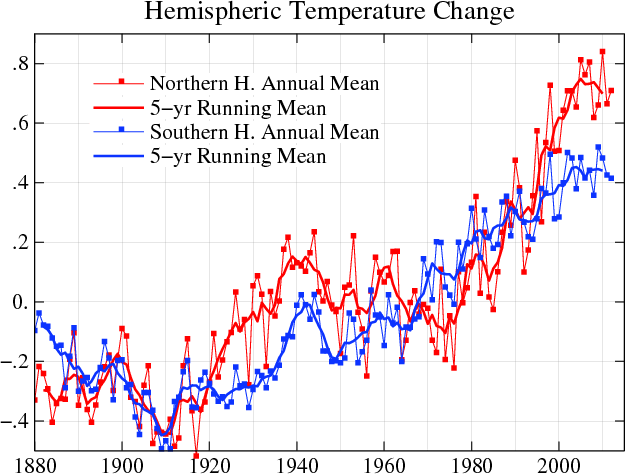
Fig. 6. This table shows both annual and five year mean temperature variances between 1880 and 2011. Temperature mean averages for the northern hemisphere are in red and southern hemisphere averages are in blue (NASA Goddard Institute for Space Studies, 2012). http://data.giss.nasa.gov/gistemp/graphs_v3/Fig.A3.gif
Sea Ice Loss
The significance of sea ice loss in the Arctic relates to a serious tipping point in the Arctic marine ecosystem which is given by the temperature at which water changes state from solid to liquid. Ice responds suddenly to changes at this temperature. This causes warming and loss of sea ice to amplify the potential changes to the climate including a reduction in albedo with the declining sea ice. Crossing the tipping point sets in motion many changes that further increases temperature in the Arctic region on top of current global warming (Duarte et al. 2012).
The ice that encompasses the Arctic has slowly been dwindling ever since a catastrophic collapse in the Arctic region in 2007. Since that point, close to two thirds of the ice has vanished compared to a decade earlier when the loss of sea ice was significantly smaller (Anderson, 2009). Scientists had previously predicted that the ice in the Arctic region would not be reduced to the point that it reached in 2007 until at least 2050, and in 2012 it dropped to levels much lower than in 2007 (Fig. 7). It is now predicted that the Arctic summer ice could disappear entirely as early as 2013.
The vulnerable setting of the Arctic region has certainly made it easy for global warming to have significant influences on the natural climate processes. The white ice naturally reflects sunlight back into space, but with the melting of the ice and subsequent open, dark sea water, the reflectivity is reduced and therefore the heat is retained instead. The arctic seas warm up, melting more ice, and then even more is absorbed and melted by the increasing water temperature change. This creates a dangerous feedback loop that intensifies melting and overall temperatures.
Observations and climate models are in agreement that through the 21st century, Arctic sea ice extent will continue to decline in response to fossil fuels being burnt and greenhouse gases being released into the atmosphere. Through the influxes of heat being circulated, temperature for the terrestrial and aquatic systems continues to increase, delaying ice growth during winter and autumn only to increase the temperature on the region.
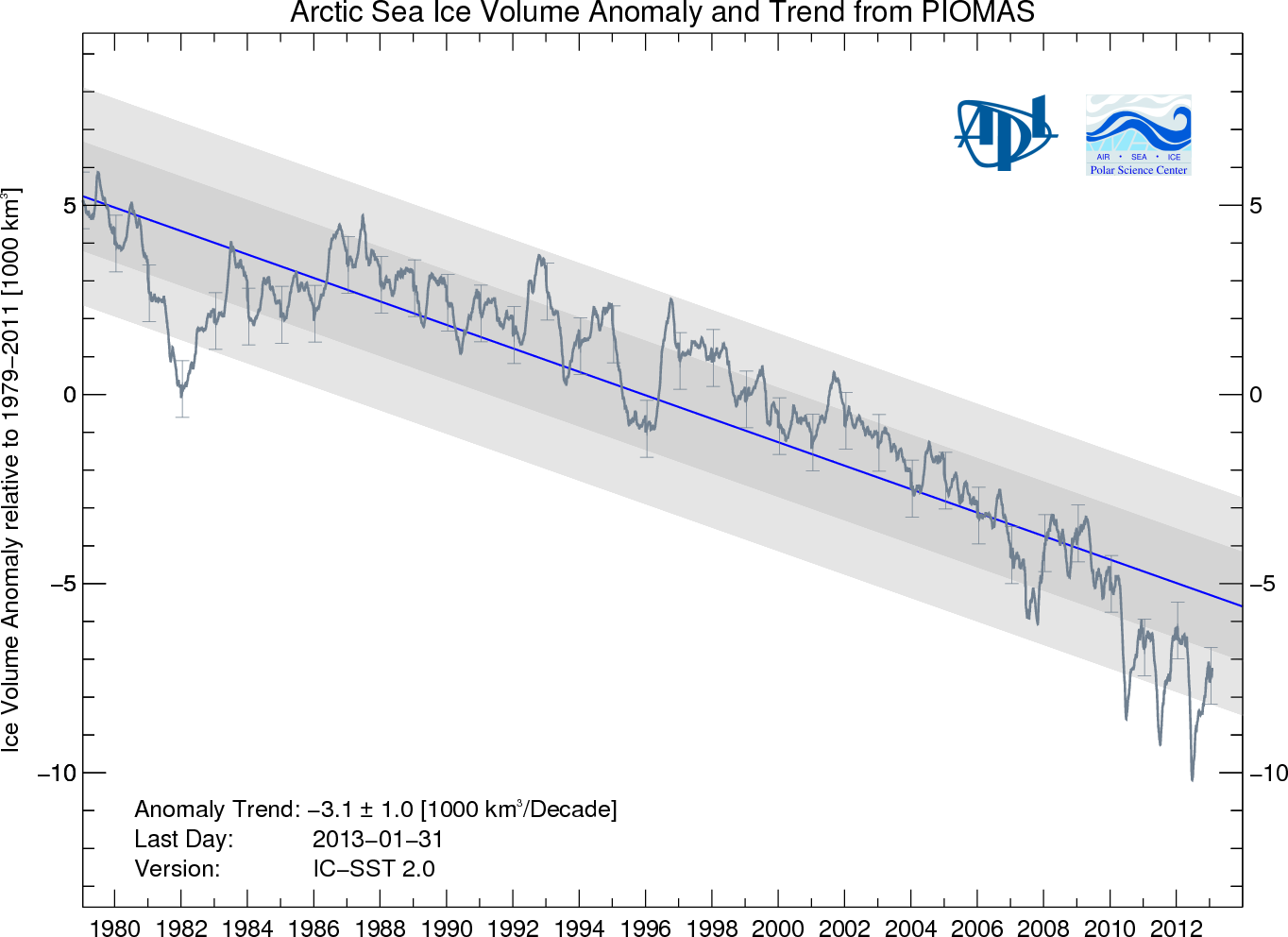
Fig. 7. This table shows the ice volume anomalies of the Arctic ocean, with respect to the volume of ice over a period between 1979 to 2011. (Polar Science Center, psc.apl.washington.edu. 2011) http://psc.apl.washington.edu/wordpress/wp-content/uploads/schweiger/ice_volume/BPIOMASIceVolumeAnomalyCurrentV2.png?%3C%3Fphp+echo+time%28%29
Permafrost Melt
One of the most worrisome scenarios of a positive feedback is the thawing of huge quantities of organic material locked in frozen soil beneath Arctic landscapes. Vast quantities of carbon and methane from once rotting vegetation are stored in the frozen soil. This frozen soil is called permafrost and it contains significantly more carbon than is currently in the atmosphere.
Permafrost is defined as subsurface Earth materials remaining below 0°C for two consecutive years. It is thoroughly widespread in the Northern Hemisphere where permafrost regions occupy 22% of the land surface (Schuur et al. 2008).
The temperature, thickness and geographic continuity of permafrost are controlled by the surface energy balance. Permafrost thickness geographically ranges from 1 meter to 1450 meters depending on where the permafrost is situated. The layer that thaws in the summer and refreezes in the winter is referred to as the active layer. The thickness of the active layer ranges between 10 centimeters and 2 meters. Beneath the active layer is the transition zone, the buffer between the active layer and the more stable permafrost. The thickness of the active layer is significant because it influences plant rooting depth, hydrological processes, and the quantity of organic soil matter uncovered to the above-freezing seasonal temperatures. The growing concern is that permafrost’s relationship with the Arctic warming could lead to drastic changes for the region.
The processes that involve the transfer of stored carbon into the atmosphere have the potential to significantly increase climate warming in the Arctic region (Schuur et al. 2008). Since it only would take a few more degrees in temperature rise to tip the permafrost into rapid thawing and subsequently release huge amounts of stored carbon and methane, methane being over 20x as potent a greenhouse gas, this would result in a much larger feedback into the global GHG level rise.
A Warmer World
Industrial Civilization is on a path to heat the Earth up by 4 to 7 degrees Celsius before the middle of this century if it fails to end its carbon emissions, triggering a cascade of cataclysmic changes that will include the increase of extreme heat-waves, prolonged droughts, intensified weather patterns, the total loss of Arctic sea ice, rapid decline in global food availability, sea level rise affecting billions of people, and eventually an abrupt extinction of the majority of biological life on earth.
The solution, while not a simple one to execute, is clear: Industrial Civilization must end its reliance on fossil fuels and begin to sequester CO2 from the atmosphere immediately, reducing the atmospheric concentration of CO2 down to a safe level.
A full reference list for this article is available here: http://dgrnewsservice.org/newsservice/2013/03/reference-material1.pdf








































